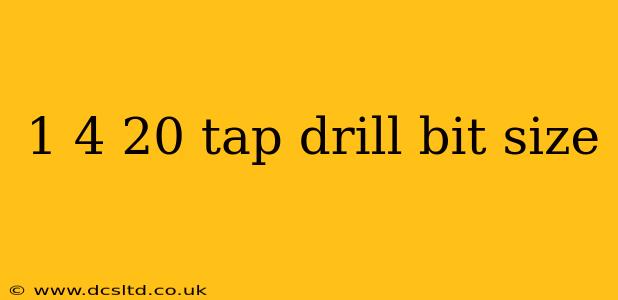Finding the right drill bit size for tapping a 1/4-20 thread can be crucial for a successful project. A too-small hole results in stripped threads, while a too-large hole creates a loose and unreliable connection. This guide will clarify the correct drill bit size and address common questions surrounding this process.
What is a 1/4-20 Tap?
Before diving into drill bit sizes, let's understand what a 1/4-20 tap is. The "1/4" refers to the nominal diameter of the thread (approximately 0.25 inches). The "20" indicates the number of threads per inch. This means there are 20 complete threads within one inch of the screw's length. Understanding this helps in selecting the appropriate drill bit.
What Size Drill Bit Do I Need for a 1/4-20 Tap?
The recommended drill bit size for a 1/4-20 tap is #7 (.201"). This leaves enough material for the tap to create strong, clean threads without causing breakage or stripping. Using a slightly smaller bit is generally not recommended, as it could lead to binding and thread damage.
However, the ideal drill size can vary slightly based on the material you're working with. Softer materials might allow for a slightly smaller drill bit, while harder materials might require a slightly larger one. Always consult a comprehensive drill and tap size chart for the most accurate information specific to your materials.
What Happens If I Use the Wrong Drill Bit Size?
Using an incorrectly sized drill bit can lead to several problems:
- Too Small: The tap will struggle to cut the threads, leading to breakage of the tap or stripped threads in the workpiece. You'll end up with a unusable hole.
- Too Large: The threads created will be weak and loose, resulting in an unreliable connection. The screw may not hold properly, potentially leading to failure under load.
Choosing the correct drill bit size is vital for a successful and long-lasting threaded connection.
What are the Different Types of Taps?
There are various types of taps, each designed for different applications and materials. The type of tap used influences the ideal drill size to a small degree. However, for a 1/4-20 tap, the #7 drill bit remains a suitable starting point for most common tap types, such as:
- Hand Taps: Used for smaller, more delicate work, often requiring more precise drilling.
- Machine Taps: Designed for use with tapping machines for faster, more efficient threading.
- Spiral Point Taps: Designed to clear chips effectively during tapping, reducing the likelihood of breakage in tougher materials.
How Do I Ensure Accurate Drilling?
Precise drilling is crucial for successful tapping. Here are some tips to help ensure accuracy:
- Use a drill press: A drill press offers greater control and accuracy compared to a handheld drill.
- Use a center punch: Mark the drilling location accurately before drilling to prevent the bit from wandering.
- Use cutting oil or lubricant: This reduces friction and heat, preventing the bit from overheating and improving the quality of the hole.
- Go slowly: Avoid applying excessive pressure, allowing the bit to cut effectively.
What are some other important factors to consider when tapping threads?
While the drill bit size is essential, several other factors can affect the outcome:
- Material properties: The material's hardness, toughness, and machinability affect tap selection and the ideal drill bit size.
- Tap type and condition: A damaged or worn tap will not produce clean threads.
- Tapping technique: Proper tapping technique, including the use of cutting oil, minimizes the chance of thread damage.
By following these guidelines and choosing the correct #7 (.201") drill bit, you can significantly improve your chances of success when tapping 1/4-20 threads. Remember to always prioritize safety and use appropriate safety equipment when working with tools and machinery.
